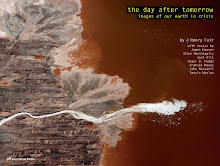April 15, 2008
Through a Spanish friend (a disaster relief specialist), I learned about a tremendously toxic site in the South of Spain called “Las Balsas.” A little investigation showed indications similar to sites in the USA of current interest, specifically phosphate fertilizer processing.
The word “fertilizer” evokes a pastoral image of grazing cattle transforming a sun-drenched field of grass into nutrients for crops, beckoning us back to simpler times. However, the super-productive modern agricultural system is fed by mineral phosphate, the principal American source being Florida, where its strip-mined extraction devastates vast areas of undeveloped wildlands, and ends with a dead zone in the ocean, where it finally comes to rest after wreaking havoc on the soil, watersheds and ecosystems in its path.
The Balsas Fosforos is residue from the processing of phosphate rock mined in Morocco, Togo, and Senegal. This rock is washed and processed with acid to make the final fertilizer. The process produces 5 parts of waste for every 1 part usable fertilizer, releases large amounts of fluorine gas (highly toxic), and produces much waste uranium and radium, byproducts found with the phosphate. The large volumes of highly acidic, radioactive waste are stored in giant unlined “impoundments” covering 1200 hectares. The mixture is so acidic, it can eat a hole in the earth and cause “sinkholes,” in which the mixture pours down to the aquifer beneath it. In 1998, a break in the embankment caused between 40,000 and 400,000 cubic meters of this highly toxic liquid to spill into the waterway, less than 1km from the town of Huelva.
So, of course I had to go shoot it.
Then my friend (thank you Alejandro) mentioned that the original Rio Tinto mine was right there in the same vicinity. The Mine (from which the mining company draws its name) is one of the largest holes in the ground and produced a large part of the world’s copper, silver and iron ore. According to myth, this is the legendary mine of King Solomon, and the reputation of great mineral wealth drew invaders from around the world that have shaped the history of Spain. The river and estuary systems there make up one of the largest heavy metal-contaminated waterways in the world, and the water can run blood red (Rio Tinto).
The rates of cancer in the Huelva-Sevilla area are significantly higher than the national average in Spain as documented by Joan Benach, a researcher specializing in occupational health at Barcelona's Pompeu Fabra University.
This region of Spain had been on my “must shoot” list for quite some time. Of course, then it was just a matter of finding a reason to go to that part of the world. Nicolai from Köln came into the picture, made a few phone calls, and suddenly TVE Television became interested in the project and said they would do a documentary. And there is always the Prado, with its special Goya exhibit: In The Times Of War. Suddenly, the trip made perfect sense; it was just a matter of when.
The Southwest of Spain stands as one of the world’s premier vacation areas; Goya is known to have recuperated from illness and distress in Cadiz. Sevilla stands as the quiet Spanish pendulum opposite Barcelona. And of course, the food is fantastic, not to mention the unique Spanish aspect of “old world charm.” The Moorish influence on Spain is ever-present, hidden in architectural flourishes and culinary tendencies.
I flew to Madrid and spent a few days, saw the Goya exhibit, and, even better, saw his “Black Paintings.” Amazing. These are visions of a future based on his impressions of man, Goya knew him to be. He painted them on the plaster walls of his house, which were essentially removed to the Prado.

Then it was off to Jerez de la Frontera, southwest of Sevilla, near the mine sites and the home of the pilot we had found. Arriving late at night, in need of rental car and hotel room, makes getting up at the crack of dawn less than ideal. Jerez is a long way from the Rio Tinto mine, where I was scheduled to meet the TVE team; I arrived just in time for an early lunch of delicious pig (try not to remember the hog story), then off to the mines, which proved to be better than imaginable.

We filmed and did interviews in several locations, and set up a nice rapport. “El Escarabajo Verde” is the TVE environmental program. The most hopeful sign of all for me is the universal interest in environmental issues. People are hungry for answers.
We were set to fly out of Jerez the next day, but suddenly the crew mentioned that they had worked with a pilot based much closer to the mines. Using this pilot would save them a lot of time the next day, but it was a bit like changing horses in the middle of the race to book a different pilot for dawn, only a few hours away. Enter Curro, a very able, but laid back pilot.

We plotted our course, and Curro added a few sites of interest (local knowledge is such a help). There are architectural remnants that reach back to some unknown era of imperial exploitation by British technology, deep mining pits, trails to walk, sheep happily munching the grass, a complete mining train abandoned in its tracks.
More to come...










